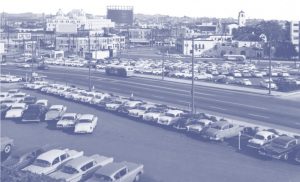Minimum parking requirements create more parking than is needed. This in turn encourages more driving at a time when cities seek to reduce congestion and increase transit use, biking, and walking. After nearly a century of development under these requirements, parking now dominates our cities.
To counter the problem of excessive minimum parking requirements, academics and practitioners have advocated a new suite of parking policies, including reduced parking requirements and demand-based prices for on-street parking. These policies aim to better manage parking and reduce driving, but too much parking works against these goals by spreading the destinations and making the cost of driving artificially low. To more effectively address the issues caused by minimum parking requirements, planners and policymakers should focus not only on future development, but also on the existing parking oversupply.
Relatively little information exists, however, on the amount and location of parking in cities, limiting our understanding of how that parking contributes to land and automobile use patterns. To address this knowledge gap, we developed a case study to estimate where parking infrastructure exists in Los Angeles and how it has evolved over time.
Parking in Los Angeles County
Most cities in the United States, have required off-street parking spaces in their zoning and building codes since the 1950s. They require developments to provide specified amounts of off-street parking based on land use and project size. What makes Los Angeles unique and well suited for our case study is that 1) a majority of the buildings were erected following the adoption of minimum parking requirements, 2) the pace of construction has slowed dramatically in recent decades, largely due to spatial constraints, and 3) the region is unlikely to see extensive new development.
With a building stock and parking supply that are largely “locked-in,” even drastic changes to parking requirements are likely to have little impact on the total number of spaces in the region. To understand how this parking may affect policies intended to curb the use of automobiles, city planners need information on where current parking exists and how much of it there is.
Los Angeles is widely recognized for its automobile dependence and associated issues with traffic congestion. Covering 4,700 square miles, Los Angeles County includes 88 incorporated cities. To evaluate the impact of minimum parking requirements in the county, we estimated the number, location, and year of construction for off-street residential, off-street non-residential, and on-street parking over the past century.

To develop these estimates at a scale that will be useful for policy decisions, we combined models of building and roadway growth, land use and building types, and historical minimum-parking requirements covering 55 types of zones. Because there was significant consistency from one city’s parking ordinances to another’s, we used the median parking requirements from a sample of 19 incorporated cities. Estimates of the on-street parking supply excluded portions of the roadway that would not have on-street parking, such as driveways, bus stops, fire hydrants, and intersections.
Parking Quantity
As of 2010, Los Angeles County had 18.6 million parking spaces, including 5.5 million residential off-street, 9.6 million non-residential off-street, and 3.6 million on-street spaces. This amounts to more than 200 square miles of parking spaces, equivalent to 14 percent of the county’s incorporated land area (Figure 1). Even though Los Angeles has one of the densest road networks of any metropolitan area in the US and is recognized worldwide for its expansive freeway system, the total area dedicated to on- and off-street parking is 40 percent larger than the 140 square miles dedicated to the roadway system.

While perceived parking shortages are often used to defend minimum parking requirements in metropolitan areas, there are 3.3 spaces for each of the 5.6 million vehicles in the county (1.0 residential off-street, 1.9 non-residential off-street, and 0.6 on-street spaces per vehicle). Although certain areas of Los Angeles do struggle with an imbalance between parking supply and demand, these results show that the indiscriminate application of uniform parking requirements has led to a large oversupply of parking in many areas.
Parking Growth
Los Angeles is a relatively young region, and a majority of its parking infrastructure was built during the second half of the 20th century. Between 1950 and 2010, the city added 12 million of its 18.6 million total spaces. The greatest rate of growth in total spaces occurred between 1950 and 1980, when an average of 310,000 spaces were added annually. During this time period, parking grew faster than the number of road lane miles, contributing to increased auto use and resulting congestion. Average space additions slowed to 190,000 per year from 1980 to 2010. By 1990, the growth of residential and roadway infrastructure also slowed. More recent increases in parking spaces across the county have mainly been the result of additional non-residential parking spaces.
Parking and the Automobile
The automobile was ascending to modal dominance in Los Angeles when minimum parking requirements were codified. As a result, parking spaces grew faster than cars, leading to a significant oversupply of parking. The rate of car ownership, however, soon caught up, and surpassed the growth or parking spaces. By 1975, the number of vehicles in the county equaled the number of off-street residential spaces. Since then, this ratio of vehicles to off-street spaces has remained consistent, approaching one to one in 73 percent of the census tracts in Los Angeles County. Residential off-street space requirements may be effective at preventing cruising for street parking in neighborhoods, but the results indicate that they incentivized vehicle adoption, ultimately contributing to additional vehicle miles traveled and congestion.
Parking Density
The growth of parking has varied across the county. Since 1950, much of the growth in parking occurred outside the urban core in low-density residential and commercial developments. Neighborhoods within the urban core, however, have the greatest parking space densities (Figure 2). The central business district has the highest density of parking spaces, most of which are associated with nonresidential development. This abundance of parking in areas with high-quality transit and dense mixed-use limits transit use, cycling, and walking. While we did not directly assess how the parking supply affects congestion, we suspect that high parking density contributes to localized congestion on nearby roads. Reforming existing parking requirements may limit parking additions in the future but is unlikely to address existing congestion issues.

Reducing the Parking Supply
Our findings suggest that cities should reduce the existing oversupply of parking, which encourages automobile travel and deters alternative modes. It may be necessary to reduce the number of existing parking spaces to fully realize the positive impacts of these policies.
There is also a substantial opportunity to redevelop our cities by transitioning existing parking to alternative land uses. Space for development is limited in urban areas, but our findings show that a significant portion of developable land in Los Angeles is dedicated to parking. While repurposing parking lots or structures may offer the greatest opportunity for large redevelopment projects, planners should also consider the benefits of transitioning residential parking, especially home garages, toward other uses. Converting residential parking spaces to additional dwelling units, for example, could help alleviate the housing shortage in Los Angeles.
Reducing the existing parking supply will likely meet strong resistance in a region that is largely car dependent and, in the short-term, could increase cruising for parking and congestion. In order to reduce car dependency and its associated problems in the long term, however, existing parking should be repurposed.
Conclusion
Reforms need to go beyond reducing or removing minimum parking requirements. Cities can encourage converting parking to other uses. While parking may dominate urban landscapes today, new uses for this land and capital can provide a path to a brighter future.




















